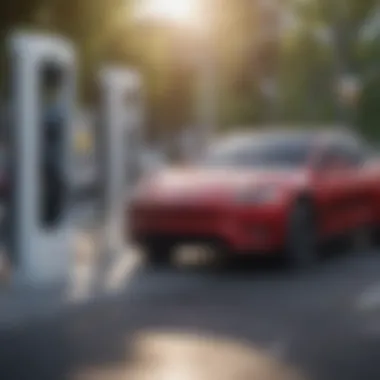Evaluating Electric Vehicle Recharge Costs: A Comprehensive Analysis


Intro
The shift towards electric vehicles (EVs) is becoming evident globally as more consumers look for sustainable and cost-effective transportation options. Understanding the costs associated with recharging an EV is vital for potential owners and enthusiasts. This analysis will offer insights into various factors affecting recharge costs, helping to differentiate between EVs and traditional gasoline vehicles.
Current Trends
Overview of Automotive and Boating Markets
The automotive market is experiencing a significant transition towards electric power. In recent years, major automakers have increased investments in EV technology, aligning with environmental regulations and consumer demand. Similarly, the boating sector is also exploring electric-powered vessels, though the adoption is not as widespread as in cars.
Key Drivers Influencing Purchases
Several factors influence the purchasing decisions for EVs:
- Environmental Concerns: Growing awareness of climate change pushes consumers to choose greener options.
- Economic Incentives: Many regions offer tax credits and rebates for buying electric vehicles, making them more attractive.
- Technology Advancements: Improvements in battery technology have increased range and reduced charging times, bolstering consumer confidence in EVs.
Cost Structure of Recharging EVs
Electric vehicle recharge costs depend on multiple elements, including electricity prices, charging location, and charging speed. Here are some essential aspects:
- Electricity Rates: Costs vary by region and can fluctuate based on peak and off-peak hours. Understanding local electricity rates is crucial for calculating the total recharge cost.
- Charging Stations: Public charging infrastructure includes fast chargers and Level 2 chargers. Fast chargers typically cost more but offer quicker recharges.
- Duration of Charge: The longer the vehicle is plugged in, the higher the costs can be, especially if charged during peak hours.
"The cost of electricity to recharge an EV can vary widely. By knowing local electricity prices, owners can optimize their charging schedules and potentially save money."
Future Trends in EV Charging Infrastructure
As the demand for electric vehicles grows, so will the charging infrastructure. Expect advancements in charging technologies and an increase in the availability of charging stations. The integration of renewable energy sources will likely further impact recharge costs, making it essential for consumers to stay informed.
In summary, by understanding the cost dynamics at play in recharging electric vehicles, consumers can make informed choices. This article aims to provide a comprehensive overview for automotive and boating enthusiasts, evaluating all relevant aspects of EV charging and its implications.
Understanding Electric Vehicle Charging Costs
The evaluation of costs associated with recharging electric vehicles is a central aspect of their adoption and sustainability. This section seeks to clarify and offer insights into the various elements that shape these costs. Understanding these factors plays a vital role for automotive enthusiasts and potential EV owners alike. Knowing what influences charging costs helps in making informed decisions, maximizing savings, and, ultimately, understanding the total cost of ownership for electric vehicles.
What Determines the Cost to Recharge an Electric Vehicle
The cost to recharge an electric vehicle depends on a variety of factors. These include the local electricity rates, the charging station's pricing structure, and the type of EV battery capacity. Additionally, the time taken for charging affects the overall cost, especially in areas where time-of-use rates apply. Each of these elements can significantly sway the financial equation for electric vehicle ownership, thus requiring careful consideration from users.
Types of Electric Vehicle Charging Stations
Electric vehicle charging stations are classified into different levels based on their voltage and speed of charging. Understanding these types is essential for estimating costs effectively and planning your charging needs.
Level Charging
Level 1 charging is the most basic form of charging available. It uses a standard 120-volt outlet, which is commonly found in homes. This form may seem slow, requiring overnight charging for a full recharge, yet it has some benefits. One key characteristic is its accessibility; almost any household can provide this option. It is particularly beneficial for EV owners who can charge their vehicles at home without installing special equipment. However, the long charging time and relatively low power output are notable disadvantages.
Level Charging
Level 2 charging provides a quicker alternative compared to Level 1. It operates on a 240-volt outlet and can be installed at home or found in public charging stations. With the capability to charge an EV in a few hours instead of overnight, it offers a significant advantage for those with a busy schedule. One of its unique features is the flexibility it offers, allowing owners to charge during times when electricity rates may be lower. Although the installation of a Level 2 charger may involve higher upfront costs, many consider it worth the investment for the convenience it provides.
Fast Charging


DC Fast Charging is the quickest charging option available. This type provides high-voltage charging directly to the vehicle's battery, significantly reducing charging times to around 30 minutes for most EVs. Its key characteristic is the rapid charge rate, making it suitable for long trips or for those in need of a quick power boost. However, these stations may have higher costs associated with them per kilowatt-hour compared to other forms. The availability of DC Fast Charging can also vary significantly by region, which may impact accessibility and convenience for users.
Regional Variations in Charging Costs
Regional differences play an important role in the financial implications of charging an electric vehicle. Electric rates, local incentives, and infrastructure development all vary from one area to another.
Urban vs. Rural Rates
Urban areas tend to have higher electricity rates compared to rural regions. This can impact the overall cost of charging an electric vehicle significantly. Urban charging stations might also implement higher fees due to higher operational costs. On the other hand, rural users may have a more balanced situation with lower rates and fewer charging options, which could mean longer travel distances to access a charging station.
State and Local Regulations
State and local regulations can also shape the cost of charging substantially. Different regions have various incentives for installing charging infrastructure or for EV owners themselves. Some locations might subsidize charging costs or offer tax breaks, while others may impose higher tariffs for usage or require different business permits for public charging stations. Understanding these regulations is crucial as they can influence overall affordability and availability across different regions.
Electricity Pricing Models
Understanding electricity pricing models is crucial for evaluating the cost to recharge electric vehicles. These models dictate how much EV owners will spend for charging their vehicles and can significantly affect overall ownership costs. As the adoption of electric vehicles expands, knowing these pricing structures helps users make informed decisions regarding charging options. Cost-saving opportunities can be identified, and users can better budget their monthly expenses when charging costs are considered.
Time-of-Use Rates
Time-of-use rates are a dynamic pricing model based on the time electricity is used. Under this system, electricity prices vary throughout the day. Typically, rates are lower during off-peak hours, encouraging users to charge their vehicles when demand is less. This pricing model rewards users for shifting their energy consumption patterns, resulting in potential savings. For instance, charging an EV during the night may cost substantially less than charging during the day. However, customers need to manage their charging habits effectively to maximize savings.
Also, utility companies may offer different rate designs that incentivize off-peak usage. For instance, an EV owner could face a steep bill if charging is done during peak hours when electricity demand peaks. Thus, awareness of specific time slots for lower rates is vital for optimizing costs.
Flat Rate Charging
Flat rate charging provides a straightforward approach. Under this model, users pay a fixed fee for electricity used regardless of the time of day. This type of pricing eliminates the complexity of varying rates and makes budgeting simpler for some EV owners. However, while flat rate charging provides predictability, it may not always be the most cost-effective choice. Consumers in regions where rates are significantly cheaper during off-peak periods might miss out on savings that a time-of-use model could offer.
Flat rate charging can be beneficial for users who prefer convenience over savings. Having a consistent price allows for planning without the need to monitor energy usage actively. However, it is essential to assess one’s usage patterns. In some cases, flat rate services may include additional fees that can increase costs.
Membership and Subscription Models
Membership and subscription models have gained popularity as electric vehicle owners look for more flexible charging solutions. These models often charge users a monthly fee in exchange for access to a network of charging stations. Benefits can include reduced per-charge costs or unlimited charging. For heavy users, membership can lead to considerable savings compared to pay-per-use models.
Moreover, some providers offer tiered subscription plans, allowing users to select levels according to their charging habits. This option can appeal to diverse user needs, from casual drivers to frequent travelers.
However, before committing, potential users must evaluate their charging behavior. A thorough cost analysis comparing potential monthly fees with frequency of use is necessary. An uninformed choice could lead to higher costs if the subscription does not align with actual charging needs.
As the EV network evolves, electricians pricing models will also evolve, presenting varying opportunities for savings.
Comparative Analysis: Electric vs. Gasoline Vehicles
Understanding the differences between electric and gasoline vehicles is essential for informed decision-making. This section highlights critical elements such as ownership costs, long-term savings, and maintenance expenses. Evaluating these components will help potential buyers assess the true financial implications of switching to electric vehicles.
Cost of Ownership Overview
The cost of ownership is a vital metric when comparing electric vehicles (EVs) to traditional gasoline cars. Expenses typically considered include the purchase price, insurance, taxes, fuel costs, and any potential incentives. While the initial price for an EV may be higher, factors such as federal tax credits can help to offset this.
Moreover, electricity costs vary widely based on location and the time of charging. According to data, EV owners can expect to save on fuel costs due to lower electricity rates compared to gasoline prices. In urban areas, where gas tends to be more expensive, the savings can become more pronounced. Additionally, purchasing an EV might make you eligible for incentives aimed at promoting electric mobility, which enhances overall savings.
Fuel Savings with Electric Vehicles
One of the most compelling arguments for electric vehicles is the significant savings on fuel. EVs operate on electric power, which is often cheaper than gasoline. On average, charging an electric vehicle costs about half as much per mile when compared to gasoline.


- Example Calculation: If charging costs $0.13 per kWh and an EV consumes about 25 kWh to travel 100 miles, the cost per mile would be approximately $0.0325. In contrast, if gasoline costs $3.00 per gallon and a gasoline vehicle averages 25 miles per gallon, the cost per mile would be $0.12.
These figures demonstrate that for many, the long-term savings on fuel can add up quickly, making EVs a financially viable option.
Maintenance Cost Differences
When it comes to maintenance, electric vehicles present a distinct advantage. Generally, EVs have fewer moving parts compared to gasoline vehicles. They do not require oil changes, and their brake systems tend to last longer due to regenerative braking. This means owners can expect to spend less on routine upkeep over the vehicle's lifespan.
Typical maintenance costs for gasoline vehicles may exceed $1,500 annually, depending on the age and model. In contrast, EV maintenance might average around $900 to $1,200 annually, leading to further savings over time.
"The lower maintenance costs associated with electric vehicles can add significant savings to their overall cost of ownership."
Charging Infrastructure Developments
The evolution of charging infrastructure plays a vital role in the overall ecosystem of electric vehicles (EVs). As more consumers transition from traditional gasoline cars to electric vehicles, the breadth and efficiency of charging networks must keep pace. This infrastructure is crucial for addressing charging costs and user experiences. In turn, improvements in technology and government support can enhance the reliability and accessibility of these charging stations.
Expansion of Charging Networks
The expansion of charging networks directly affects the affordability and feasibility of owning an electric vehicle. More charging stations across a wider geographic area make it easier for EV users to locate convenient recharging options. Rural areas often lag in charging availability, which can deter potential EV buyers in those regions. While many urban centers have developed extensive networks, a continued focus on building out infrastructure in less-populated areas is essential.
In many cases, companies such as ChargePoint and EVgo are leading the charge by installing more charging stations. Additionally, partnerships between private corporations and local governments can foster this growth. Further increased accessibility will not only encourage current EV owners but also motivate those on the fence about switching to electric.
Technological Advances in Charging Stations
Advancements in technology are instrumental in enhancing the user experience and efficiency of EV charging stations. Improvements in smart and ultra-fast charging technology create an environment where recharging an EV is not seen as a burden, but part of a new lifestyle.
Smart Charging Solutions
Smart charging solutions leverage technology to optimize when and how charging occurs. Key features include real-time data monitoring, automated scheduling, and integration with renewable energy sources. This is particularly beneficial because it allows EV owners to charge their vehicles during off-peak hours when electricity rates are typically lower. This approach is an efficient way to manage costs, especially for those on time-of-use pricing plans.
On the downside, some users might discover a learning curve when adapting to these systems, which might seem complicated at first. However, their long-term benefits outweigh initial resistance. Smart charging can suit different driving patterns and truly personalize the recharging experience.
Ultra-Fast Charging Technologies
Ultra-fast charging technologies represent another leap in EV charging capabilities. These systems significantly reduce the charging time, often allowing a vehicle to regain a substantial amount of range in under 30 minutes. The main characteristic that makes ultra-fast chargers appealing is their rapid power delivery, providing speeds that can reach up to 350 kW.
While the advantage of speed is undeniable, the infrastructure required to install ultra-fast charging stations can be costly. Factors such as energy source capacity and the grid's overall readiness come into play. Ultimately, regions that embrace ultra-fast charging technology can greatly enhance the practicality of electric vehicle ownership and broaden their market appeal.
Government Incentives for Charging Infrastructure
Government incentives are essential for encouraging the development of charging infrastructure. These can take many forms, including tax credits, grants, and subsidies for installation of charging stations. By reducing financial barriers, governments enhance the appeal of electric vehicles.
Moreover, policy initiatives that promote green technologies often lead to an increase in the number of charging stations. City planners and local governments that prioritize sustainable transportation will likely encourage investment in charging facilities. This creates a ripple effect, encouraging more energy companies and private entities to invest in infrastructure.
These advancements in charging infrastructure not only lower costs associated with recharging EVs but they also build user trust and contribute to a greener environment. As the industry progresses, staying attuned to developments in this sphere remains crucial for both consumers and policymakers alike.
User Experiences and Feedback
User experiences and feedback play a crucial role in understanding the overall landscape of electric vehicle charging costs. Insights from actual users inform prospective EV owners about the practicalities and nuances of charging their vehicles. The unique experiences of users can reveal both the strengths and weaknesses of different charging options.
Public Charge Station Reviews


Reviews of public charging stations provide valuable feedback on their functionality, accessibility, and cost-efficiency. Users often share their firsthand experiences regarding the reliability of these stations. Common aspects evaluated include the charging speed, service outages, and user interface of charging stations.
Electric vehicle owners frequently discuss their experiences in online forums and social media. Platforms like Reddit and specialized automotive blogs serve as essential sources for this information. For example, a review may highlight the user-friendliness of a Tesla Supercharger or criticize a slower public charger from a different brand. Such reviews assist potential users in making informed decisions about where to charge their vehicles, considering both convenience and expense.
"Finding a reliable charge station is as important as vehicle performance. Charging time can really impact the day-to-day experience of owning an EV."
Finding Cost-Effective Charging Options
Identifying cost-effective charging options is essential for maximizing savings when using electric vehicles. Users are often on the lookout for ways to reduce their charging expenses. Several strategies can be employed to achieve this.
- Utilizing Apps: Many smartphone apps can help users locate nearby charging stations along with relevant price points. These applications may also indicate whether a station is functioning.
- Considering Time-of-Use Rates: Some users take advantage of favorable electricity pricing during off-peak hours. By charging at night when rates are lower, they can significantly cut their electricity costs.
- Checking Local Incentives: Many regions offer incentives or rebates for using public charging stations. Customers can explore these options to see if they qualify for savings.
- Subscription Services: Some stations provide subscriptions for regular users. This can lead to reduced costs over time if a user frequently charges their vehicle at the same locations.
By leveraging user-generated reviews and various strategies to find cost-effective options, current and future EV owners can navigate the nuances of charging expenses with greater ease.
Future of Electric Vehicle Charging Costs
The future of electric vehicle charging costs is a significant topic for current and prospective EV owners. As the electric vehicle market grows, it is essential to analyze the factors that will influence charging costs in the coming years. Understanding these dynamics can help potential buyers make informed decisions. Among the critical elements to consider are predicted trends in electricity pricing, the impact of renewable energy on charging expenses, and the role of governmental policies that shape these costs.
Predicted Trends in Electricity Pricing
Electricity pricing is not static; it evolves based on several factors including demand, generation sources, and regional market conditions. As the adoption of electric vehicles increases, it is expected that peak demand will shift. This shift could initially lead to higher electricity rates during peak hours due to increased consumption. However, some industry experts anticipate that as utilities invest more in infrastructure and optimize their grids, electricity prices may stabilize.
Time-of-use rates may also become more common as a way to encourage EV owners to charge at off-peak times. This pricing model can result in cost savings as electricity is usually cheaper during non-peak hours. Consumers must stay informed about local pricing structures.
Impact of Renewable Energy on Charging Costs
The integration of renewable energy sources into the grid has a profound effect on charging costs. As more solar, wind, and hydropower resources are used, the overall cost of electricity could decline. This could make charging electric vehicles more cost-effective compared to conventional fuel. Additionally, off-grid charging solutions powered by solar panels can reduce dependence on the traditional grid and lower costs for EV owners.
However, fluctuations in renewable energy generation can present their challenges. The availability of sunlight and wind varies, impacting the reliability of these energy sources. Therefore, energy storage solutions will play a crucial role in mitigating these fluctuations and providing stable charging costs.
The Role of Policy in Shaping Costs
Government policies are instrumental in influencing the cost of electric vehicle charging. Incentives such as tax credits, grants, and rebates can significantly reduce the cost of installation for charging stations. In some regions, state and local policies mandate the incorporation of EV charging infrastructure in new construction projects, further enhancing accessibility.
Regulatory measures that support the development of a cohesive charging network can lead to lower costs for consumers. Additionally, policies that favor sustainable energy practices can further drive down charging costs by promoting cleaner energy sources. As these policies evolve, they will undoubtedly shape the future of electric vehicle charging infrastructure and associated costs.
"With the right policies and investments in technology, the future of electric vehicle charging can be both affordable and sustainable."
In summary, the future of electric vehicle charging costs hinges on several interconnected factors. Stakeholders must pay attention to trends in electricity pricing, the increasing role of renewable energy sources, and the impact of existing and emerging governmental policies. By keeping these elements in mind, both existing and potential EV owners can navigate the evolving landscape of electric mobility with greater confidence.
Ending
The conclusion of this article serves as an important point of reflection on the financial dynamics surrounding electric vehicle (EV) charging costs. Understanding these elements is crucial for current and prospective EV owners, as it allows them to make informed decisions that align with their lifestyle and budget. The intricate factors that influence charging costs can significantly impact the overall ownership experience, making it essential to grasp these components thoroughly.
Summarizing the Key Points
Throughout the discussions, we have explored several vital aspects that affect the cost to recharge an electric vehicle:
- Determinants of Charging Costs: Factors like electricity pricing, station type, and location play a significant role.
- Electricity Pricing Models: Different pricing models, such as time-of-use rates, can lead to varied expenses, influencing how and when individuals charge their vehicles.
- Comparative Analysis: We examined how EV ownership offers fuel savings compared to traditional gasoline vehicles, thus altering the expenses over time.
- Infrastructure Developments: Innovations in charging technology and growing networks are reshaping the charging landscape, providing enhanced options for EV drivers.
- Future Trends: The potential for renewable energy integration and policy impacts could further change the cost structure in coming years.
These points weave together a comprehensive understanding of the financial implications tied to EV charging.
Considerations for Future EV Owners
Future EV owners should contemplate several factors when assessing the costs associated with charging:
- Research Local Rates: It's advisable to investigate local electricity rates and available charging stations. Understanding the existing infrastructure can lead to better charging choices.
- Evaluate Charging Needs: Each owner’s driving habits and daily needs can influence whether a Level 1, Level 2, or DC Fast Charging station is ideal for them.
- Explore Incentives: Many regions offer financial incentives or rebates for EV purchases and charging stations, which can lessen the overall cost of ownership.
- Watch for Trends: Keeping an eye on trends in renewable energy use and emerging policy changes can inform decisions related to future costs and infrastructure development.
By considering these elements, potential EV owners can navigate the evolving landscape of electric vehicle charging more adeptly, ensuring that they are well-prepared for the costs that come with this transition to cleaner transportation.







